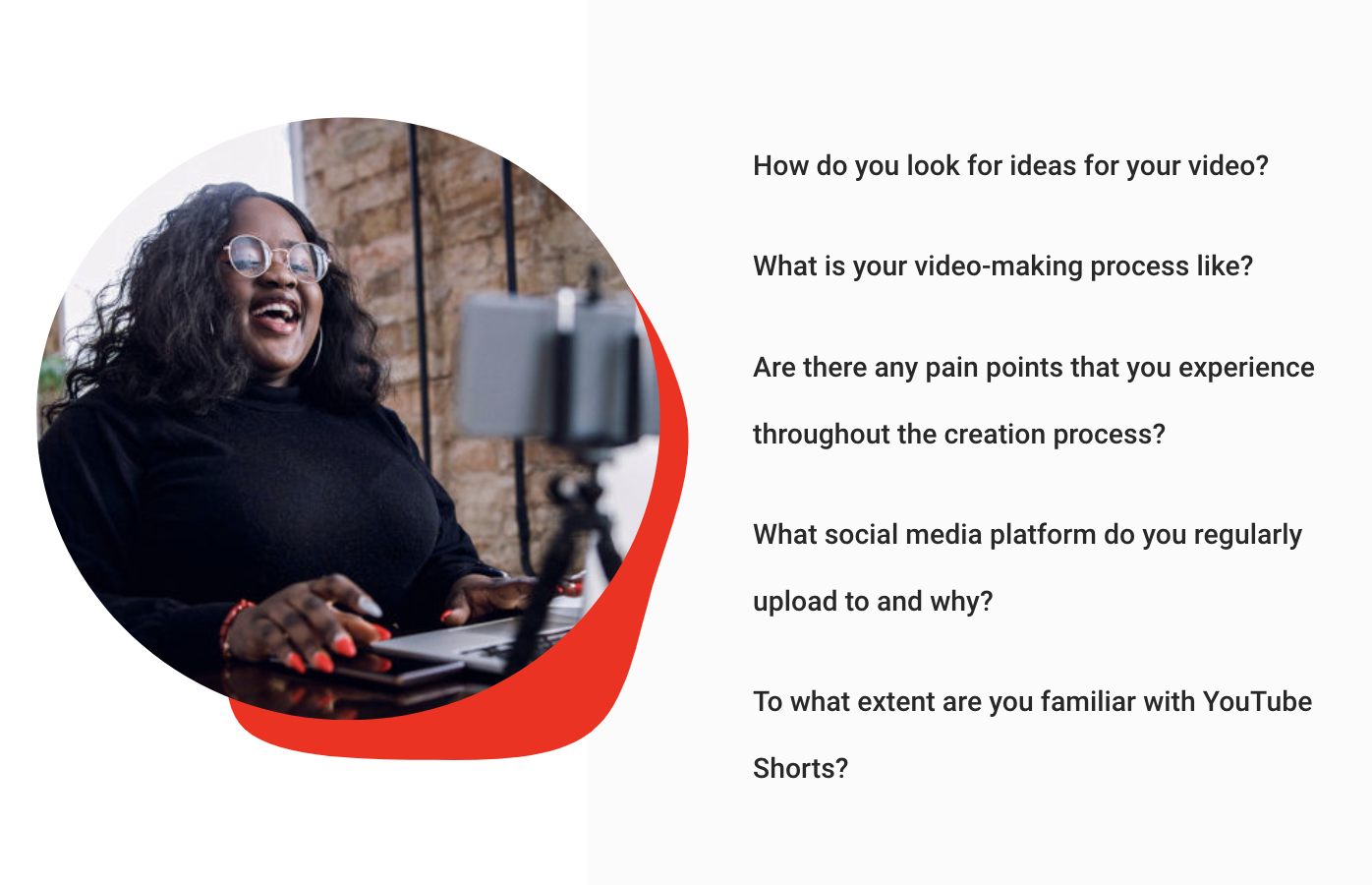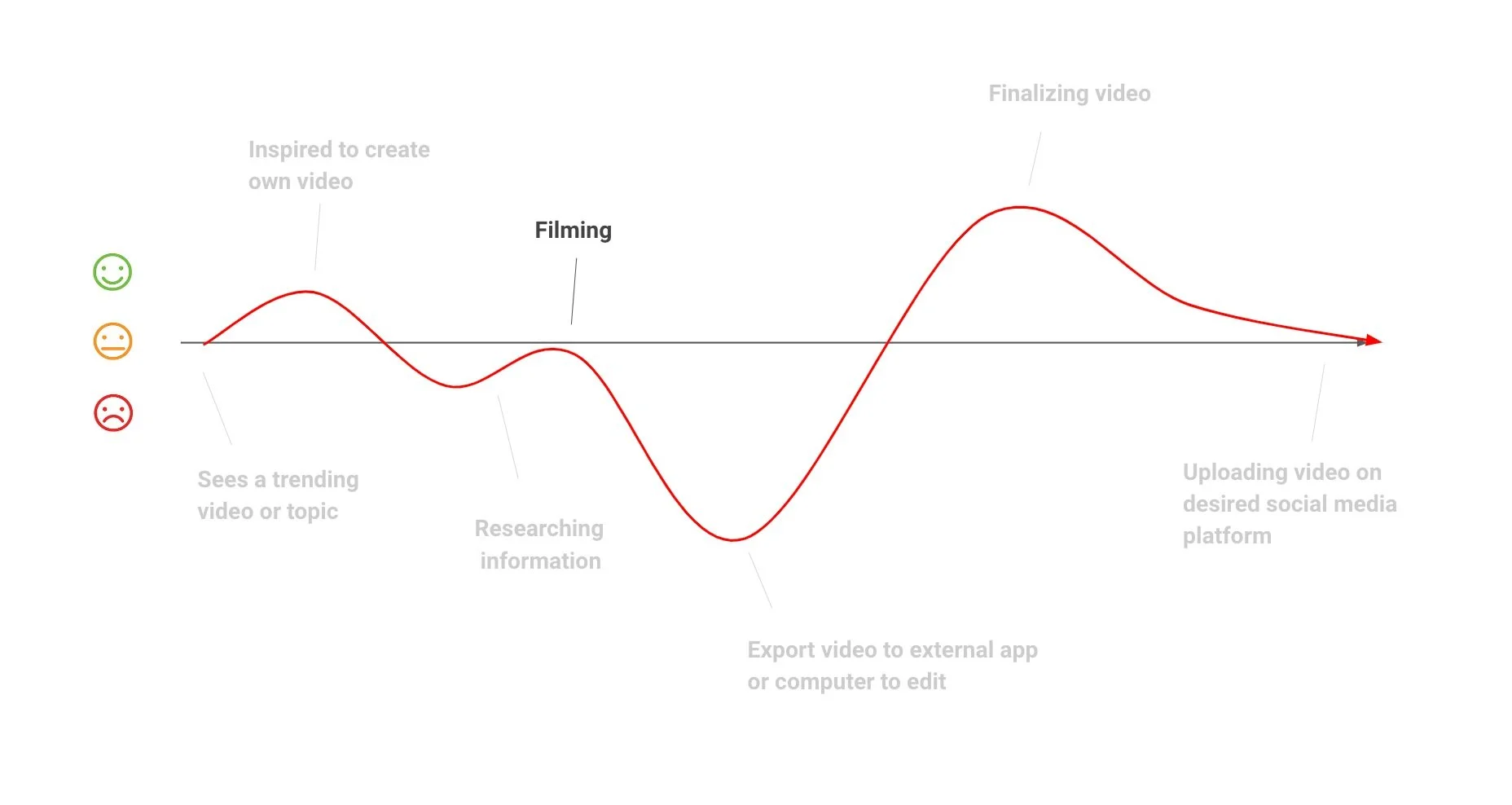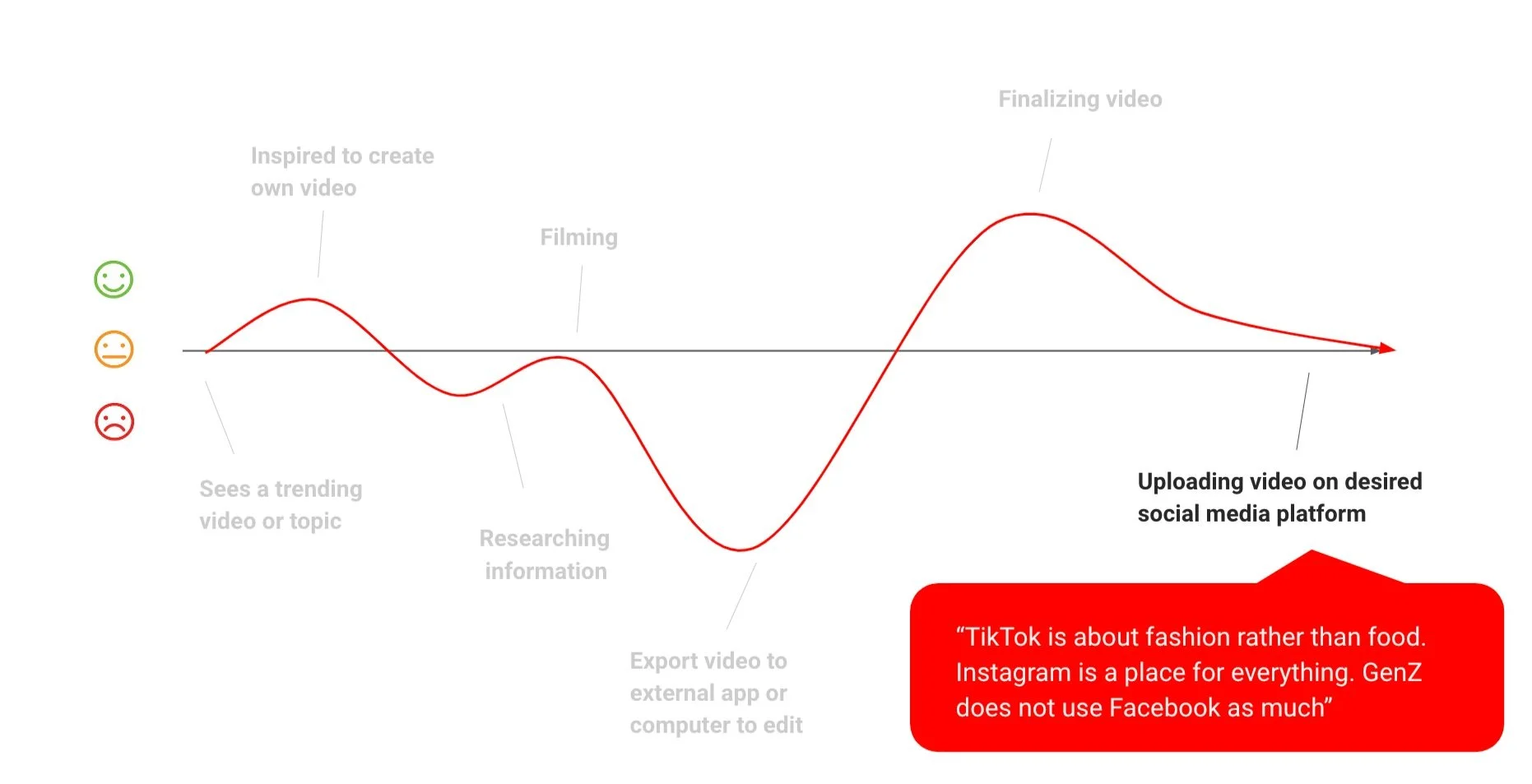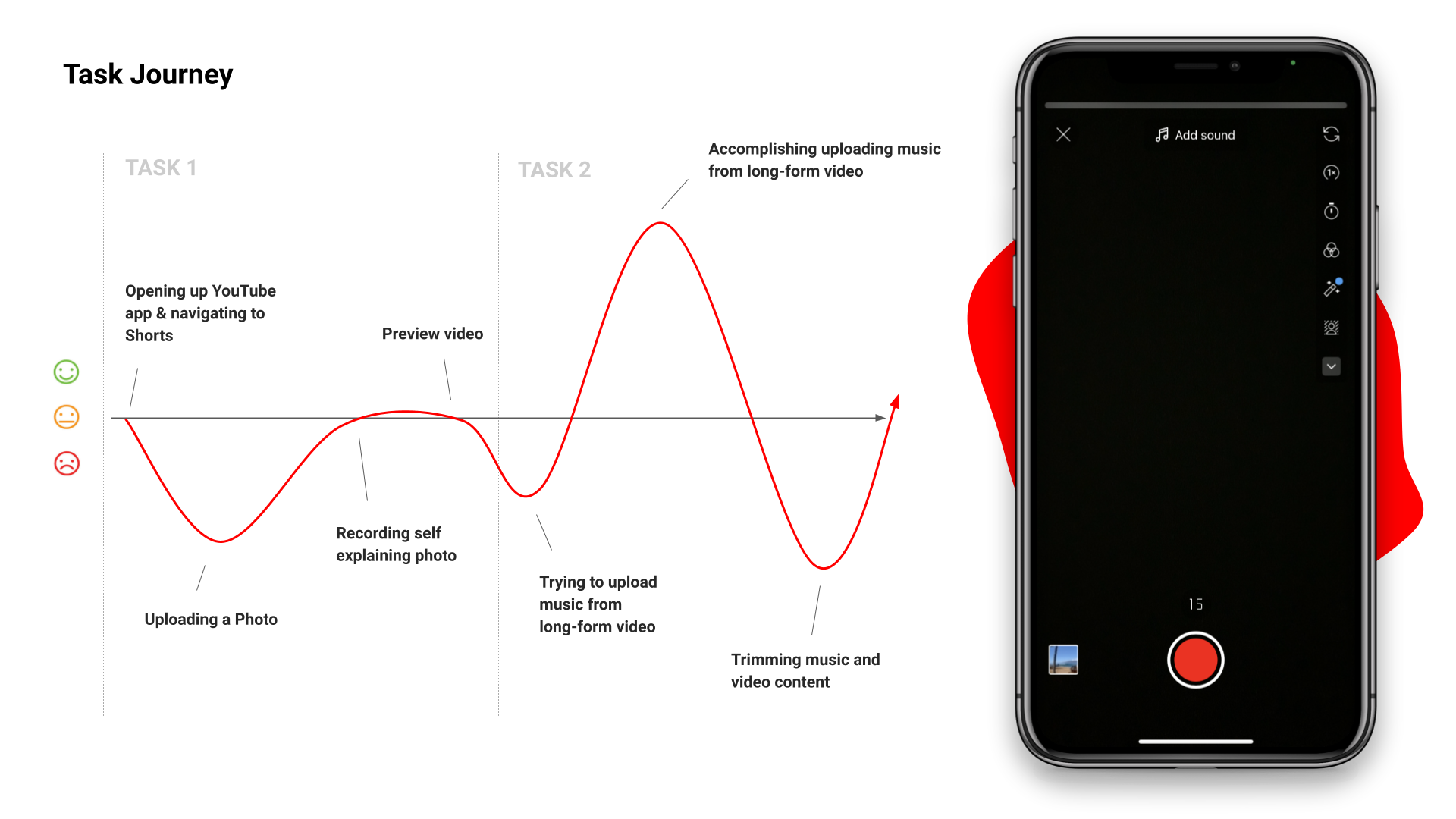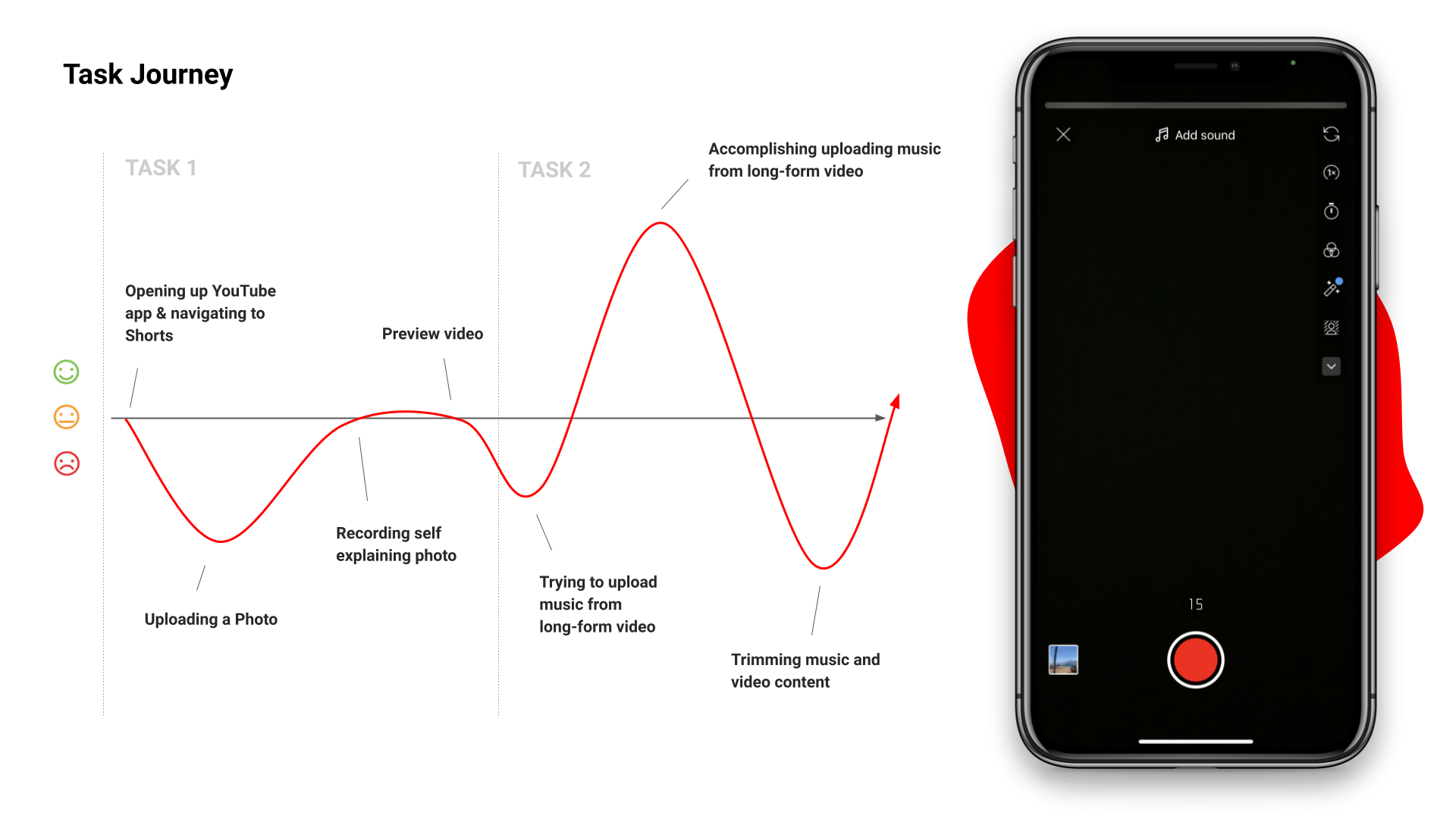Enhancing YouTube Shorts: Strategic UX Research for Optimized User Experience
Illinois Design Consulting partnered with YouTube Shorts to conduct an evaluative UX research project aimed at enhancing the platform’s usability for content creators. Through comprehensive usability testing, we uncovered key pain points, usability challenges, and areas for improvement. The goal of this research was to provide YouTube with actionable insights to create a more intuitive and streamlined experience that supports content creation and fosters user engagement in the competitive short-form video landscape.
The Team
Jabari Cooke(UX Researcher)
Sarah Chang(Project Lead)
Ethan Igunbor(UX Researcher)
Gabriel Tan(UX Researcher)
Allison Oh(UX Researcher)
Skylar Atwell(UX Researcher)
My Role
As a UX Researcher for the YouTube Shorts project at Illinois Design Consulting, I conducted moderated usability tests, crafted and refined test questions, gathered user insights, and analyzed key results. My work led to actionable recommendations that guided design improvements, ultimately enhancing the overall user experience on the platform.
Research Goals
Project Goal: Assess the usability of YouTube Shorts in comparison to other short-form content-creating apps.
Objective: Gain insights into content creators’ processes and perspectives on short-form video content.
Experience Translation: Examine how creators’ experience with other short-form apps affects their interaction with YouTube Shorts.
Outcome: Identify and address pain points and strengths within the YouTube Shorts app to enhance the user experience for content creators.
Research Methodology
We conducted user interviews to gather in-depth insights into content creators' perspectives on short-form video creation. These interviews included targeted questions to understand their experiences and challenges with similar platforms. Building on these insights, we developed user journey maps to visualize and analyze each stage of the video creation process from the creators' perspective. Due to time constraints, we followed up with three moderated usability tests specifically focused on evaluating the natural flow of content creation within YouTube Shorts, providing us with qualitative and actionable insights for enhancing the user experience.
User Interviews
Recruitment:
To ensure a diverse range of perspectives, we recruited content creators from various backgrounds:
Personal Network: Leveraged personal connections to access a variety of creators familiar with short-form video content.
Small-Scale Influencers and Creators: Included emerging influencers to gain insights from users still building their platforms and facing unique growth challenges.
Creators with Large Followings: Engaged high-reach creators who could provide insights on the usability of YouTube Shorts from a more experienced and high-demand perspective.
Simplified Interview Guide:
To gain a deeper understanding of content creators’ perspectives, we conducted 60-minute interview sessions designed to explore their experiences with short-form videos. In these initial interviews, our primary objective was to build foundational knowledge about the content creation process from the viewpoint of those who produce it, rather than consume it. We aimed to uncover their creative workflows and thought processes by asking targeted questions that correlated directly with their experiences and challenges in creating content.
Journey Map:
After interviewing creators, we gained insights into their content creation process within their favorite short-form content apps, which we visualized in this journey map. These were the phases of their content creation process:
Inspiration: The journey begins when creators come across a trending video or topic on social media that excites and inspires them, sparking the idea of making their own version. This initial spark of interest drives them to start exploring the topic further.
Research: To develop their idea, creators dive into research, watching multiple videos or reading articles to gather information and refine their approach. This phase can be time-consuming but is crucial for ensuring their content aligns with the latest trends and meets audience expectations.
Filming: With a solid concept in mind, creators proceed to film their content, often using TikTok as their primary platform. However, they may find TikTok’s editing features limited, particularly for more complex edits.
Editing: Due to TikTok’s constraints, creators often export their footage to a computer or a more robust editing app like CapCut, Premiere Pro, or Final Cut Pro. This additional step allows them to achieve greater control over the sequence and quality of their video, enabling them to make adjustments that better reflect their vision.
Uploading and Sharing: Once editing is complete, creators upload their final video to TikTok and possibly other social media platforms. They recognize that each platform has a unique audience, so they may choose to share on multiple platforms to maximize reach and engagement.
This journey map highlights the creators' content creation process from inspiration to sharing, showcasing the excitement and challenges they encounter.
Usability Test
Recruitment:
We reached out to mainly creators or micro-influencers to focus on the usability of creating a YouTube short, many of whom were found by Illinois Business Consulting.
Usability Task:
Participants were asked to complete three core tasks:
Upload a photo to the app and then record yourself explaining the picture.
Goal: This task was designed to help us understand how users interact with the app's recording and photo-uploading features.
Pick a video from YouTube and create a new video using its audio.
Goal: This step aimed to observe how users engage with audio features and assess the ease of using existing audio to create their own content.
Our Process for the Sessions:
Introduction: Our team conducted usability testing with the content creators we recruited. Each session began with a short introduction and explanation.
Think Aloud: We utilized the think-aloud protocol to understand the user's thoughts and adopted a task-oriented approach to guide users through the usability test.
Post-Session Interview & Defrief: After concluding the testing, we asked a few questions to debrief in a semi-structured interview format.
Analysis and Synthesis Process:
The team had been parallel synthesizing and debriefing after each project phase. However, once the sessions were coming to a close, we held a rapid synthesis session to analyze what we had learned from the users. Plotting pain points, categorizing themes and topics, and going over each usability session helped us deconstruct the current short-form user experience.
Results
To better understand and illustrate the results from our moderated usability test, we created a journey map that visualizes user pain points and highlights areas of confusion in a clear and accessible way. Below is the journey map showing each task and the challenges users faced along the way.
Task 1: Uploading a Photo and Recording a Voiceover
For the first task, users were instructed to upload a photo from their camera roll, record themselves explaining the photo (with the photo in the background), and then preview the video. Immediately upon opening the app, user pain points began to emerge. All three users struggled with locating the photo upload option, initially assuming that tapping the square box icon in the bottom left corner would allow them to access photos. However, this button only displayed videos, not photos, causing frustration. It took a few minutes of trial and error before users managed to find the correct way to upload a photo.
Once they successfully uploaded the photo, all three users completed the remaining steps with ease, recording their explanations, previewing the video, and successfully completing Task 1.
Task 2: Uploading a Clip from a Long-Form Video and Create Content
Task 2 presented additional challenges for the users. They needed to upload a clip from a longer video—a process none of the participants had previously attempted. Users initially struggled to find the correct feature, clicking on various buttons before discovering the “Create” button, which allowed them to clip a portion of the audio and use it in a new video.
Once they figured out how to select a clip, users were impressed by this feature, noting that it set YouTube Shorts apart from other platforms like TikTok, which lacks a similar extensive audio library. However, the next pain point arose when users tried to fine-tune the audio clip. All three users found it challenging to locate the trim feature due to unclear icons and a lack of familiarity with this function, leading to additional frustration.
This journey map effectively outlines the stages of the content creation process within the app, capturing moments of user confusion and highlighting opportunities for interface improvement.
Key Insights
Key Insight #1: People are excited about the possibilities of leveraging long-form videos for short-form content.
Usability participants expressed excitement and positive feelings about pulling audio from an existing long-form video and using it in a Short.
“The best thing was that you can just add songs from other YouTube videos.” - 21 y/o, small-scale creator
“I think I’m going to start using YouTube Shorts. I never knew that I could search up music and use the background music.” - 19 y/o, large-scale creator
Key Insight #2: For better or worse, people approach using Shorts the same as they do TikTok.
Participants often mentioned the similarities between Shorts and TikTok. This familiarity helped them navigate certain features but sometimes hindered their ability to navigate others.
“We’re more familiar on how to use these features on the app that it was created for.” - 19 y/o, small-scale creator
“It’s really similar to Instagram or TikTok. It was easy.” - 19 y/o, large-scale creator
Impacts
Operational Efficiency in Feature Updates: By implementing usability insights, such as clearer iconography and feature organization, the platform can improve user navigation, making it easier for creators to utilize advanced editing tools without external applications. This reduces the need for additional user support and increases workflow efficiency.
Enhanced Cross-Platform Appeal: Recognizing that users approach YouTube Shorts similarly to TikTok, we can leverage familiar features while highlighting unique aspects, enhancing the appeal for creators who already use multiple short-form platforms. This dual familiarity and distinction support both user retention and cross-platform engagement.
Higher Engagement with Unique Features: Emphasizing YouTube Shorts' distinctive ability to pull audio from long-form videos encourages content creators to explore creative possibilities, fostering a stronger connection to the platform and setting it apart from competitors like TikTok.
My Learnings & Achievements
Insight on Competitive Differentiation in Short-Form Content: Observed that while short-form content apps are widely popular, unique features specific to each platform play a crucial role in attracting content creators. My analysis underscored that distinctive elements, like YouTube Shorts’ ability to leverage long-form video audio, can entice creators to choose one app over another.
Understanding Creator Workflow and Interaction Patterns: Through research, identified that content creators maintain a consistent workflow across platforms, impacting their approach to YouTube Shorts. This insight helped the development team understand how familiar, cross-platform processes could be optimized within Shorts to improve user experience and ease of adoption.
Resilience and Flexibility in Stakeholder Collaboration: Navigated complex stakeholder requirements, demonstrating resilience and adaptability in the research process. Recognized the importance of adjusting methods and communication strategies to address varying expectations, which strengthened collaboration and ensured that research outcomes aligned with stakeholder goals.

